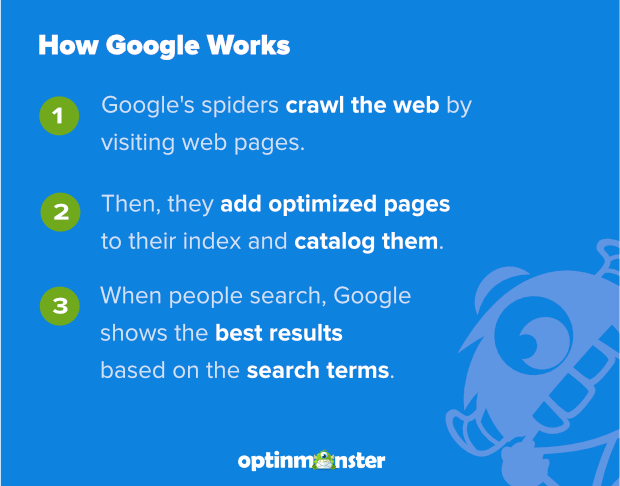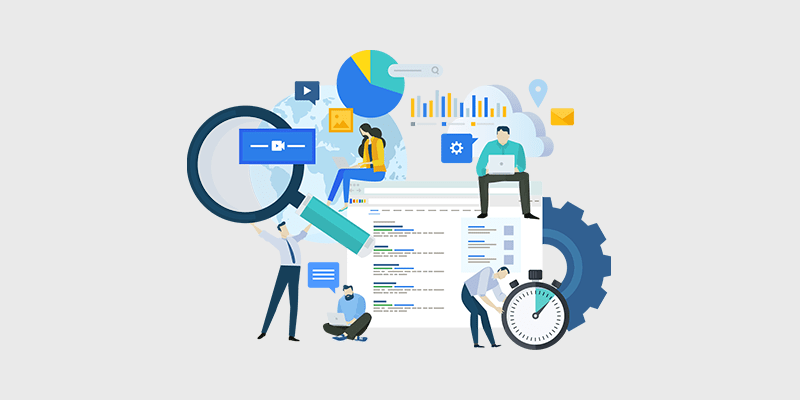
L
ooking to learn about SEO and boost your blog’s traffic? Well you’re in luck! You’ve just discovered the best SEO for bloggers guide to massively grow your blog’s traffic.
This isn’t the average run of the mill SEO for beginner’s guide which you can find everywhere on the internet. We have made sure that we covered everything there is to cover about SEO which can help you pave your way to the top of Google rankings.
This guide is especially designed for newbies who are just starting to get to know about SEO for bloggers.
In this guide we have talked about practical examples that
we have tested ourselves. You are going to learn about strategies that are working in
2019, and different trends that you need to follow this year.
Needless to say, if you were looking to improve your SEO game this year then you’ll love this guide.
Let’s look at the content we are going to be discussing in this guide.
Fundamentals of Search Engine Optimization
SEO stands for search engine optimization. It’s the process of optimizing your content online in a way that it stands out, which makes search engines like Google to show it on top for search rankings for a certain keyword.
When you optimize your content the right way, you’ll see your content ranking on top of Google and every other search engine.
Pro Tip: If you want to excel in SEO, make the right website for the right people.
If you want your blog posts to rank in search results, you’ll need to write content that matches what people are search for. This is know as “search intent.” If you satisfy the intent of the searcher, then you’ve done your job as a blogger.
Why Should I Learn SEO for Bloggers?
If you want to get your site ranked on the first page of Google and other search engines, then you need to learn SEO.
Optimizing your website for search engines is the best way to grow your traffic exponentially over time.
Social media or paid ads might give you a spike of traffic for a day, or send you visitors as long as you keep paying. But learning SEO is an investment that will keep paying off over time.
These days, everyone uses search engines to find what they need.
That’s why it’s important to position yourself to be found when they do.
Basic SEO Terminology
There are some terms that you are going to hear a lot that might have you scratching your head. To get you started, here are few terms that you need to be aware of when learning SEO for bloggers.
- On-page SEO is everything that you do on your website, from using certain words in your content to technical aspects like the way your site is coded.
- Off-page SEO is everything you do to promote your website and improve its authority off your site, like getting backlinks from other authority websites.
- Backlinks acts like votes that you get from other websites. Google considers these as proof that your content is good enough to be ranked on the top. The more quality backlinks you have the easier it will be for you to rank.
- Black Hat SEO are practices that violate Google’s policies and can get your site penalized. Black Hat SEO may bring you short term success, but you won’t stay at the top for long. Sooner rather than later, you will be sacked by Google. We strongly advise against this.
- White Hat SEO is the opposite of black hat SEO. In other words, it’s SEO done the right way. Stick to this if you’re in for the long run!
These should help you get going for now. Now let’s move on
to the next chapter.
Back to the top
How Search Engines Work
Before we get to the part where we explain how you can do SEO to rank high on search engines, we need you to understand how search engines work.
In this section. we will also talk about how people use search engines, how it works, ranking factors, algorithms and different features of search engine results pages (SERPs).
The process is simpler than you might think. Search engines have bots, also called spiders, that crawl the contents of a web page. After it’s done crawling, Google uses that information and runs it through their secret algorithms to decide where to rank it in the search engine results pages.
If you have optimized your page correctly, the bots will
index your page on the relevant keyword that you want to target. This also
depends on the various algorithms of Google and other search engines, which we
will talk about in detail below.
Search Engine Ranking Factors
Did you know that there are over 200 different things that Google looks at to determine how to rank each web page? These are called “ranking factors”.
Don’t worry, we aren’t going to go through all 200 of them here!
Not all of them are very important or require your attention. I’ll just give you some tips on how to optimize for the most important ranking factors.
Here are the most important:
- Referring domains
- Organic click-through-rate
- Domain authority
- Domain relevancy
- Mobile usability
- Dwell time
- Total number of backlinks
- Content quality
These are in no particular order, by the way.
Here’s a bit more info about what they all mean:
Referring domains are other websites that link to your website. If you have high authority domains linking out to you, then this will not only increase your website’s authority but it will also give you a chance to rank higher on Google.
Organic click-through-rate (CTR) is defined as the number of times the searcher clicks on your page after searching for a keyword. If you have a high CTR then you have a good chance of staying on the position you initially ranked for, and even moving up in rankings.
Domain authority is the authority of your domain which you built over time by getting quality backlinks and publishing high quality content that’s optimized for search.
Domain relevancy means that your domain should have content related to your main topic. For example, if you have a travel blog, it will be easier for you to rank on travel-related topics. If you start publishing tech news or recipes, it will be much harder to rank those in search results.
Mobile usability refers to how easy it is to use your site on mobile devices like tablets and smart phones. It helps to improve the load time of your blog so that it loads faster. You also need to work on the overall user experience (UX).
Dwell time is the time a visitor spends on your website. Let’s say that your blog is ranked at the 4th of the first page and a visitor clicks through to your blog. Your visitor really likes the content and spends time going through the information you have on your blog. Your content has satisfied the user’s intent and he leaves your site without going back to the search results and clicking on a different link. Google will take note of this and might give you a bump in your position.
Total number of backlinks is the number of links to your website from other sites around the web.
Content quality goes without saying! The better the content you create, the better the chances of getting good links. This is the foundation of SEO for bloggers.
Search Engine Algorithm Updates
Search engines, more specifically Google, make a lot of updates to their algorithms to improve their search results. You will hear the people often talk about how a certain Google update made them gain or lose their rankings.
But if you are doing everything right and following the basic Google guidelines, then you don’t have anything to worry about.
Our advice to you once you start doing SEO is that there will be times that you will be greatly rewarded after a Google update. Then there will also be a time when you might lose your rankings even though you were doing everything right.
At times like these, be patient and keep doing what is right and satisfy your visitor’s intent with good compelling content. If you stick to that, you’ll be rewarded.
Features of Search Engine Results Pages
Search engine results pages (SERPs) don’t only include lists of URLs. Google has added a lot of features to them over time. You may have noticed things like featured boxes, ads, image carousels and other features.
These are some of the most common rich snippets you’ll see
in the SERP:
- Featured snippet
- Answer box
- Carousel (images, videos, products)
- Image pack
- Map pack
- Sponsored features (Google Ads, flights, shop on Google)
- Knowledge graph
- Top stories
- Events
- Sitelinks
In 2019, the SERP feature you should target for is featured snippet. If you manage to get your site in the featured snippet, you will get a huge traffic boost.
Now we know what SEO means and how search engines work, it’s
time to move on to the good stuff.
Back to the top
We’ve already explained a bit about what on-page SEO means: everything you optimize on your own site in order to rank in search results. In this chapter we will talk about its implementation.
Back in the early days of search engines, on-page optimization was all about stuffing as many keywords as possible into your content. But as search engine algorithms have evolved, these practices have mostly ended, because they hurt more than help.
Now it’s all about understanding the user behavior and
engagement.
Let’s move on the to the on-page SEO for Bloggers Checklist.
On-Page SEO Optimization Checklist
Before you hit that publish button make sure that you check
everything off the list.
1. Research Keywords for Your Blog Post
Once you have a blog post idea, you’ll need to do some keyword research around the topic. This will help you to understand how people are searching for the topic in Google.
Find keywords that have high volume and are easy to rank.
Apart from that you need to understand the intent of the
keyword, so that it’s easy for you to right the content that will satisfy the
searcher.
To put it simply, keyword research is the first and the most important part of SEO which you can’t ignore. We will talk about keyword research below – you can click here to skip ahead to the keyword research section.
2. Optimize Your Blog Post Title and Subheadings
Now that you have your keywords, you need to use them in your title, subheadings, and throughout the content of your article.
You don’t need to forcefully use the keywords to your content. Use them naturally and make sure that you don’t stuff keywords where it doesn’t make sense or sound good. Always remember that you are writing for the reader first, then Google.
The only meta tags you need to worry about are meta title and meta descriptions. You should use your keywords in both of these. It’s easy to do this if you’re using the Yoast plugin for WordPress.
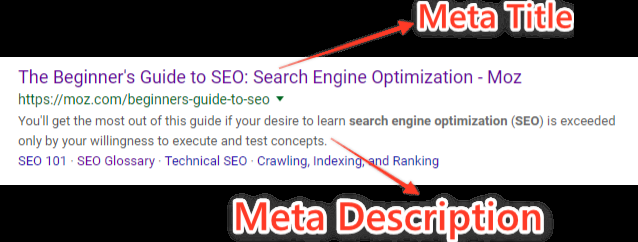
These are important because they can help you improve your
CTR (click through rate), which is ranking factor. So, you need to make sure
you get it right.
3. Use Readable URLs
This is an important aspect of SEO for bloggers especially. You would never want your blog post’s URLs to look like this:
www.example.com/2019/post318e7a349f6
Instead, you should make your URLs user friendly, so they look more like this:
www.example.com/seo-guide/
The URL should be able to show what the content is all about, and it should give a basic idea about the topic.
To ensure that your URLs are proper in WordPress, you can log in to your dashboard and click on Settings » Permalinks. Then select “Post Name” as seen in the screenshot below.
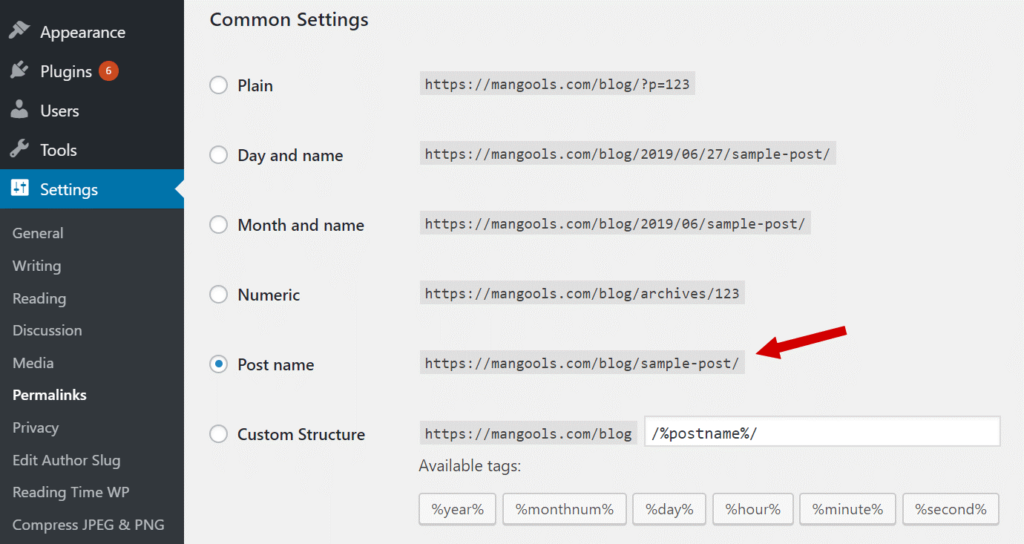
4. Add Rich Media to Your Content
Adding images and videos in your content will help engage your visitors and reduce your bounce rate and increase your average visit duration. This sends good signals to Google which helps in getting your content ranked.
Be sure that you add alt text to your images. Adding alt text to your images help Google to understand what the image is all about. It also helps in getting your images listed on Google Image search, which has potential to bring in traffic.
Always optimize your image using TinyPNG, so that it doesn’t
take too long to load.
5. Link to Other Blog Posts on Your Site
Internal links are a perfect way to drive traffic from one page to another. It makes the visitor’s stay time on your site higher, which is what you want as a website owner.
From the SEO perspective, properly placed internal links help the Google bot understand your site structure and what it’s about, and which pages are most important.
Ideally, each post shouldn’t take more than two clicks to reach from your home page.
6. Ensure Your Site Is Mobile Optimized
Almost 60% of searches comes from mobile devices like smart phones and tablets, so it’s important to have a very good and fast mobile version of your site.
Google looks at the mobile version of your site when deciding how to rank it in search results, even for searches performed on desktop. This is called “mobile first indexing.”
So if your mobile version isn’t fast enough, you won’t rank well, even if most of the traffic on your site is from people on desktops. That’s why it’s so important to have a responsive design that looks good on any theme, and to test your website speed to see if it’s fast enough.
7. Optimize Your Content for Voice Search
Voice search has gone up by 35x since 2008 and 41% of the adults now perform at least one voice search per day. Also, 20% of all mobile searches are done through voice.
That’s why it’s smart to optimize your content for voice searches, too.
In order for your result to pop-up during a voice search, you need to rank in the top 3 results.
It also increases your chances if your content is in the
featured snippet, as 4 out of 10 voice search results come from featured
snippets.
It helps to include a question and an answer in your content. Adding a “Frequently Asked Questions” section in your content can help even more.
8. Try to Get Your Content In Featured Snippets
Featured snippets, also known as “position 0”, are another factor in 2019 that you should try to optimize for when possible.
These are the boxes that show up at the top of search results:
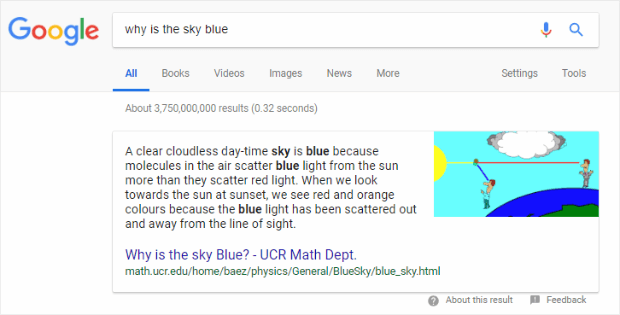
According to Ahrefs, 13% of all search results now show featured snippets. This makes it very important to optimize your content for them.
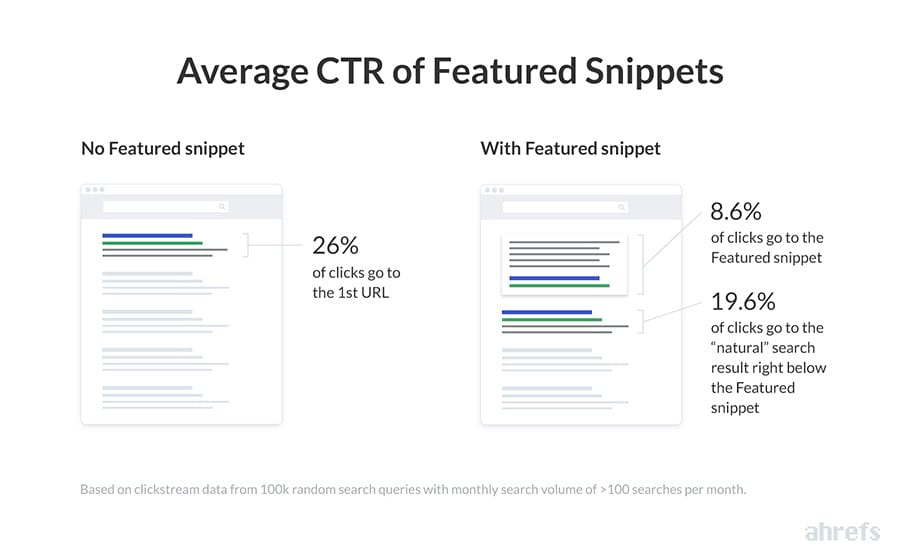
So, how does your content show up in the featured snippets?
First, you need to get you content ranked on the first page. From there, you can optimize your content and formatting to get the snippet.
Here are some types of content that gets featured in the featured snippets:
- “How to”
- “Best of”
- “Who is”
- “What is”
- “Why is”
Basically, question-related types of blog posts have a higher chance of getting in to the featured snippet.
You can read this guide on how to optimize content for featured snippets for more details and tips.
Content Marketing and SEO
Are you learning SEO for bloggers as a part of your content marketing strategy?
This is something that has actually bugged me for a long time. Sometimes people think that content marketing and SEO are opposed to each other, or that SEO is something nefarious while content marketing is pure.
Actually, we believe that content marketing and SEO go hand in hand and that they compliment each other.
One can’t succeed without the other.
Imagine if you wrote and excellent piece of content that’s filled with visuals and great information, but you don’t optimize it for search engines. Would anyone read it? Similarly, you perfectly optimize a page for search engines but it’s packed with content that no one would read. Do you think it would rank for long?
That’s why you need to create unique and compelling content and optimize it for search engines for maximum effect.
This helps in getting more backlinks and increases the reach for your content.
Effective Types of Content
First and foremost, your content should be unique and
compelling. It should be able to satisfy the reader’s intent.
There are a few types of content that get more traction then others. We have covered this in great detail in our how to get backlinks guide.
We will briefly touch upon these in this article.
- Research Based Content with Original Data
- List Posts and Tutorials
- In-depth Guides
- Visual Posts: Infographics, images, Videos etc.
These are some of the content that gets most backlinks and engagement. You should try to come up with ideas that fall in to one of the above mention content types.
For more tips and ideas, see our guide to types of blog posts that work for any niche.
What Is the Ideal Length of a Content Piece?
The ideal length of a blog post depends on how many words it
takes for you to get the message through. Remember that you are writing for the
user first then search engines.
Since we can’t outright ignore Google and other search
engines, we need to understand how they behave in terms of content length.
According to a study by Can I Rank, the word count of blog posts that were ranked in the top 3 was more than 1000. In this sense, there is a better chance of ranking in the top 3 if your content has more than 1000 words.
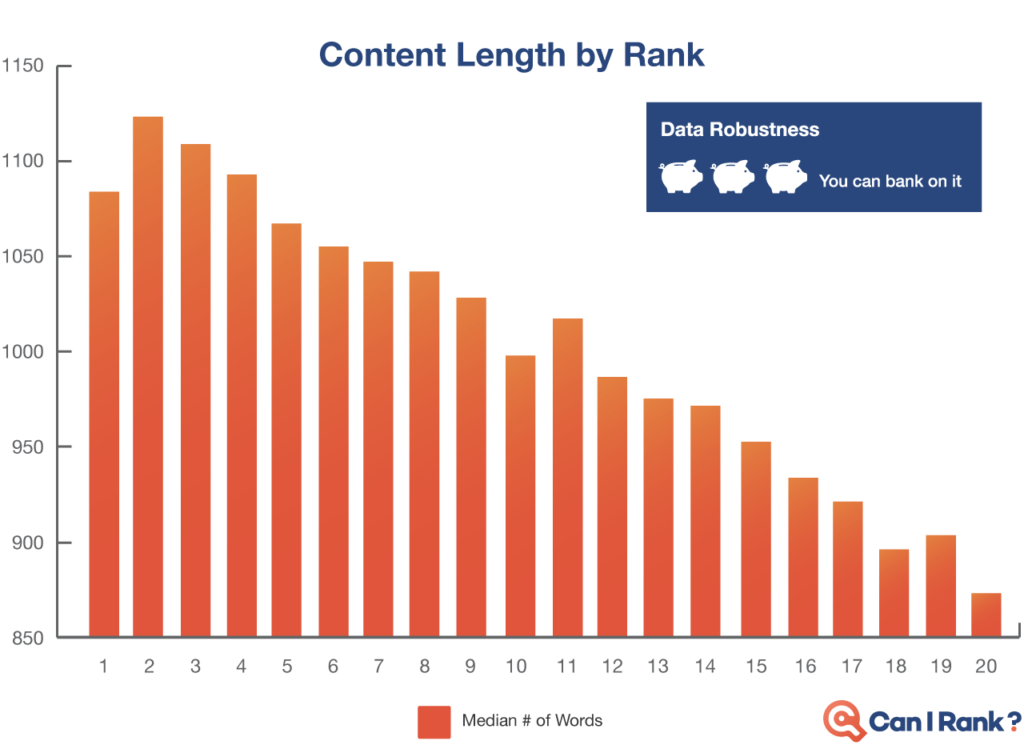
But keep in mind that your 1000 words mean anything, if your
content isn’t good enough and doesn’t get the message through.
Back to the top
How to Do Keyword Research
You can’t write an optimized post without doing proper keyword research first.
To be fair, we can’t cover everything about keyword research
in this guide. This will require a separate guide to cover every aspect of it.
But we will try our best to explain how to do keyword
research in this chapter.
Keyword Research the Easy Way
First you need to get some broad topic ideas. You can see our list of blog post ideas to get started. From there, you can come up with a list of topics to start doing research on.
There are a lot of SEO tools out there with advanced features to help you rank is search results. But for now, I’ll show you a free and easy way to do some basic keyword research.
Once you have your topic ideas, put your topic into Google Search and you will see Google suggesting a few related keywords.
Something like this.
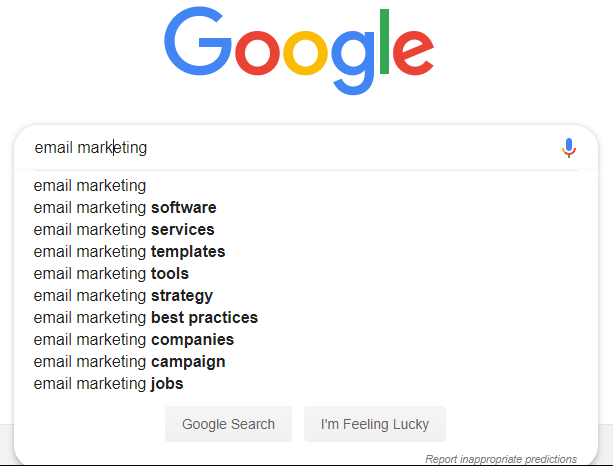
These suggested keywords are important because Google
wouldn’t show them if they weren’t being searched often.
Try using different variations of keywords and list the keyword suggestions that come up.
You may have also noticed the “Searches related to…” box at the bottom of the results page. They look something like this:
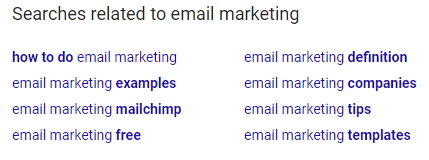
Add these to your keywords list too. And to further increase your keyword list, you can click on one of the “searches related to” keywords and then this will take you to results of the keyword you just clicked. Scroll down the bottom of the page and this will give you a list of its related keywords.
Once you are done with all of this, you will have your extensive list of keywords. So what do you do with the keywords you found? How do you short list them?
How to Choose the Right Keyword
Apart from your own judgement you can also to consider the following factors to help you rank.
Google Keyword Planner and other SEO tools can help you look up these stats.
- Search volume: When you are short listing your keywords you need to see if they have a decent volume. There is a chance to get a lot traffic if your keyword has a high search volume.
- Keyword Difficulty: Target low competition first, they will help you get ranked faster.
- Keyword Trend: Another good way to decide whether the keyword you have choose is good or not. Go to Google Trends and enter your keyword. Google Trends will show if your keyword is trending or not. If the graph is high, that means you have made the right choice.
Semantic Keywords
Semantic Keywords are those keywords that are related to your primary keyword. They are also called LSI (latent semantic indexing) keywords.
You can use these keywords in your content to make it more complete. To find LSI keywords go to LSIGraph, enter your keywords and get a bunch of related keywords for your blog post.
Quick Note: Never stuff your blog with keywords so that it sounds unnatural and forced. You will be inviting Google to strike you hard and penalize your site. This website optimization technique is old and dated, don’t let anyone else tell you otherwise.
Now let’s move on to the next chapter, link building!
Back to the top
Link Building
Link building is one of the most important factors of SEO for bloggers. It is the process of getting links from other website to increase your website’s authority.
These links acts as votes and the more you have them, the
more authority your site gets.
But there are a few things you need to know how to differentiate between good and a bad backlink.
A good quality backlink should…
- come from high authority websites
- have a relevant anchor text to your keyword
- be on relevant websites
- have the “do-follow” attribute (more on this below)
- come in from a unique referring domain
We have detailed guide on link building that goes into much more detail on all of these. But here, I’ll give you a brief overview.
Why is Link Building Important?
Google has officially stated that backlinks are among their top 3 ranking factors. While you’ll likely get some backlinks naturally if you publish great content, purposefully building backlinks can help your traffic grow much faster.
Do-Follow Links and No-Follow Links
There are two types of external backlinks: do-follow and no-follow. When you’re building links, you need to make sure that you get “do-follow” as they are the ones that help your rankings.
No-follow links don’t pass on any authority, because the publisher is basically telling Google that they want to link to this page without vouching for the site or its quality.
Luckily, most of the links you get from are do-follow unless
you get them from comments sections, profile links, press release or paid
advertisements.
If you manage to get high number of quality backlinks then
there is a high chance of you ranking in the SERPS.
How to Build Quality Links
In this section we will be talking about some popular ways you can use to build quality backlinks. For more detail see our ultimate guide to link building.
1. Resource Pages Link Building
The first way is to find websites that list useful resources. Once you have found them, reach out to them asking them to link to your content. The more resourceful your content is, the more chances it has of getting a link.
Here are some search operators you can use in Google to find resource page link building opportunities:
- “Keyword” + inurl:links
- “Keyword” + inurl:resources
- “Keyword” + inurl:useful-resources
- “Keyword” + “helpful resources”
- “Keyword” + “useful resources”
- “Keyword” + “useful links”
Make a list of potential sites, and then follow up and ask them to link to your best content.
2. Link Roundups
Website regularly link out to valuable websites, they call
this link roundups because they do it either monthly or weekly.
All you have to do is reach out to them and ask them to include your link in the next round up.
If your content is good enough, you will get a backlink in their roundups.
3. HARO Interview Link Building
HARO stands for “help a reporter out”.
It’s a platform that lets journalists send pitches to
everyone who has registered on Haro. There are a lot of big publications that
send their pitches. You will get these pitches in your email, you can respond
to the pitches you feel qualified to answer. If your pitch is accepted you will
be notified and will get a contextual link from your website.
4. Spying on your Competition
You can use check out other blogs in the same niche as yours, and get links from the sites they are getting links from. All you have to do is create better content and then ask those sites to link to your content instead.
Thank You!
We hope that our beginner’s SEO for bloggers guide helped you get started in understanding search engine optimization.
Next, you might want to check out our guide on getting more traffic to your blog, or how to get started with email marketing so you can convert those visitors into subscribers.
If you any questions or feedback, then do let us know in the comments!
